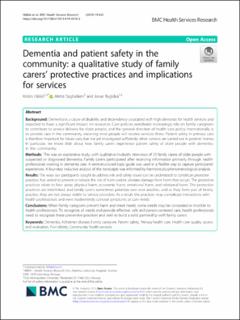| dc.contributor.author | Häikiö, Kristin | |
| dc.contributor.author | Sagbakken, Mette | |
| dc.contributor.author | Rugkåsa, Jorun | |
| dc.date.accessioned | 2020-04-06T13:10:19Z | |
| dc.date.available | 2020-04-06T13:10:19Z | |
| dc.date.created | 2019-09-25T18:59:26Z | |
| dc.date.issued | 2019 | |
| dc.identifier.citation | Häikiö, K., Sagbakken, M., & Rugkåsa, J. (2019). Dementia and patient safety in the community: a qualitative study of family carers’ protective practices and implications for services. BMC Health Services Research, 19(1), 635 | en_US |
| dc.identifier.issn | 1472-6963 | |
| dc.identifier.uri | https://hdl.handle.net/11250/2650511 | |
| dc.description.abstract | Background Dementia is a cause of disability and dependency associated with high demands for health services and expected to have a significant impact on resources. Care policies worldwide increasingly rely on family caregivers to contribute to service delivery for older people, and the general direction of health care policy internationally is to provide care in the community, meaning most people will receive services there. Patient safety in primary care is therefore important for future care, but not yet investigated sufficiently when services are carried out in patients’ homes. In particular, we know little about how family carers experience patient safety of older people with dementia in the community. Methods This was an explorative study, with qualitative in-depth interviews of 23 family carers of older people with suspected or diagnosed dementia. Family carers participated after receiving information primarily through health professionals working in dementia care. A semi-structured topic guide was used in a flexible way to capture participants’ experiences. A four-step inductive analysis of the transcripts was informed by hermeneutic-phenomenological analysis. Results The ways our participants sought to address risk and safety issues can be understood to constitute protective practices that aimed to prevent or reduce the risk of harm and/or alleviate damage from harm that occurs. The protective practices relate to four areas: physical harm, economic harm, emotional harm, and relational harm. The protective practices are interlinked, and family carers sometimes prioritize one over another, and as they form part of family practice, they are not always visible to service providers. As a result, the practices may complicate interactions with health professionals and even inadvertently conceal symptoms or care needs.Conclusions When family caregivers prevent harm and meet needs, some needs may be concealed or invisible to health professionals. To recognize all needs and provide effective, safe and person-centered care, health professionals need to recognize these preventive practices and seek to build a solid partnership with family carers. | en_US |
| dc.language.iso | eng | en_US |
| dc.rights | Navngivelse 4.0 Internasjonal | * |
| dc.rights.uri | http://creativecommons.org/licenses/by/4.0/deed.no | * |
| dc.title | Dementia and patient safety in the community: a qualitative study of family carers’ protective practices and implications for services | en_US |
| dc.type | Peer reviewed | en_US |
| dc.type | Journal article | en_US |
| dc.description.version | publishedVersion | en_US |
| dc.rights.holder | © The Author(s) | en_US |
| dc.source.pagenumber | 1-13 | en_US |
| dc.source.volume | 19:635 | en_US |
| dc.source.journal | BMC Health Services Research | en_US |
| dc.identifier.doi | 10.1186/s12913-019-4478-2 | |
| dc.identifier.cristin | 1729199 | |
| dc.relation.project | Norges forskningsråd: 256431 | en_US |
| cristin.ispublished | true | |
| cristin.fulltext | original | |
| cristin.qualitycode | 2 | |

